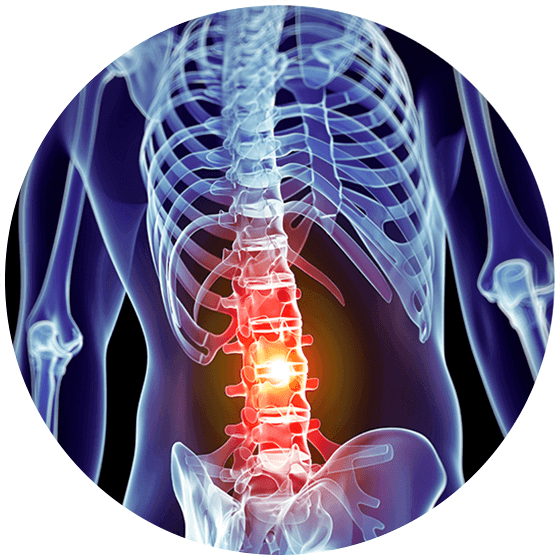Spondylolisthesis Treatment in New Jersey & New York
Comprehensive spondylolisthesis care from experienced spine surgeons who specialize in vertebral slippage treatment. We offer both conservative and surgical approaches using the latest minimally invasive techniques to restore your mobility and quality of life.

What is Spondylolisthesis?
Spondylolisthesis is a condition that occurs when one vertebra in the spine slides forward over the vertebra that sits beneath it. This vertebral slippage most commonly affects the lumbar spine (lower back), though it can also occur in the cervical (neck) or thoracic (mid-back) regions. The condition is classified into five grades based on severity:
- Grade 1: 25% forward slippage
- Grade 2: 50% forward slippage
- Grade 3: 75% forward slippage
- Grade 4: 100% forward slippage
- Grade 5: Complete vertebral displacement
Early diagnosis and treatment are crucial for preventing progression and managing symptoms effectively. Our spondylolisthesis specialists in New Jersey and New York use advanced imaging and examination techniques to accurately diagnose your condition and develop a personalized treatment plan.
Spondylolisthesis Symptoms and Signs
Spondylolisthesis can result in painful bone-on-bone contact or nerve and spinal cord compression. Depending upon the degree to which nerve function is disrupted, you may experience anywhere from mild to debilitating symptoms. Recognizing spondylolisthesis symptoms early can help you get the treatment you need before the condition worsens. Common symptoms of vertebral slippage include:
- Dull or intense lower back pain that may radiate to the legs
- Increased visibility of lordosis (swayback appearance)
- Pain, weakness, tingling, or numbness in the arms, thighs, or legs
- Muscle tension and spasms in the hamstrings or lower back
- Changes in posture, walking, or gait patterns
- Difficulty standing for extended periods
Many patients with spondylolisthesis experience no symptoms initially, and the condition may only be discovered during imaging for another spinal issue. However, symptoms can develop or worsen over time, making early evaluation by a spondylolisthesis specialist important.
If you are experiencing any of these symptoms, please contact the Advanced Spine Center to schedule an appointment. Dr. Jason E. Lowenstein, director of the spinal deformity center at Morristown Medical Center, specializes in treating conditions like spondylolisthesis. Recognized as a Top Doctor, Dr. Lowenstein will work with you to develop an individualized treatment plan that delivers long-term relief from spondylolisthesis.
Spondylolisthesis Treatment Options
Our spondylolisthesis treatment approach is tailored to your specific condition, symptoms, and lifestyle goals. We offer both non-surgical and surgical treatment options at our New Jersey and New York locations.
In advanced grades, spondylolisthesis can lead to high levels of spinal instability. Spinal fusions involve the mechanical fastening of vertebrae into place. For some, this type of surgery may be required in order to restore spinal stability or eliminate painful symptoms.
Spondylolisthesis can also lead to spinal compression and damage to intervertebral discs or nerves. Along with a spinal fusion, your surgeon may perform a spinal decompression such as a laminectomy or foraminotomy to create additional room for the spinal cord and nerves.
Depending upon the degree of movement, pain can be a minor or major symptom of spondylolisthesis. For some, oral medications like acetaminophen and ibuprofen may be sufficient. For others, prescription strength painkillers may be necessary.
Not all treatments for spondylolisthesis are operative: physical therapists can teach exercises or stretches to ease symptoms; chiropractors can adjust painful joints; and exercise or yoga instructors can help with increasing your muscular strength and spinal flexibility.
What Causes Spondylolisthesis?
Understanding the cause of your spondylolisthesis helps guide treatment decisions. There are five main types of spondylolisthesis, each with different underlying causes:
- Congenital Spondylolisthesis: Present from birth due to defective facet joint formation, making the spine more susceptible to slippage during growth and development.
- Isthmic Spondylolisthesis: Caused by a defect or fracture in the pars interarticularis (a small section of bone connecting the facet joints). This type often develops in children aged 5-7 and is common in athletes participating in sports requiring repetitive back extension.
- Degenerative Spondylolisthesis: Results from age-related wear and tear of spinal structures. Arthritis, disc degeneration, and ligament weakening can lead to vertebral instability and slippage, typically affecting adults over 40.
- Traumatic Spondylolisthesis: Occurs following acute injury to the spine from car accidents, falls, sports injuries, or other trauma that damages spinal structures and allows vertebral slippage.
- Pathologic Spondylolisthesis: Caused by underlying diseases such as spinal tumors, infections, or rheumatoid arthritis that weaken vertebral structures and lead to progressive deterioration.
Identifying the type and cause of your spondylolisthesis helps our spine specialists develop the most effective treatment strategy for your specific situation.
Concerned that you—or your child—might be suffering from a slipped vertebra? Our team of Top Doctors includes past award recipients of NJ’s Favorite Kid Doctors & The Patient’s Choice awards. Equally committed to surgical excellence and compassionate care, our fellowship-trained surgeons design a variety of surgical and nonsurgical treatment plans for spondylolisthesis and other painful conditions of the spine.
What Our Patients Are Saying
Dr. Lowenstein and team are true professionals. Extremely well versed in overall spine care knowledge. Great experience, never rushed during office visits. He was trained by the best team of doctors at Columbia Presbyterian Scoliosis and Spine in NY of whom I had personal surgery from 25 years ago. I highly recommend this team. You will not be disappointed with their overall care, compassion and direction for your needs.
-Anthony F. ⭐️⭐️⭐️⭐️⭐️
Met with Dr Lowenstein back in January, he was informative and talked me through my situation and options. He performed surgery in early Feb which was successful and he and his team have been working with me throughout my recovery. […]
-Gary G. ⭐️⭐️⭐️⭐️⭐️
I had Dr Lowenstein and he was absolutely great. I like the most about him that he’s very straight doctor and he’ll tell you what’s wrong with you and what needs to be done. He did a spinal surgery for me and took a tumor that was pressuring my spinal cord. I was carried to his office since I could not walk already, numbness of my body was getting worse and now after two weeks after my surgery I am walking again!
-Lolita D. ⭐️⭐️⭐️⭐️⭐️
Minimally Invasive Surgery for Spondylolisthesis
When surgical treatment is necessary, our spondylolisthesis specialists utilize advanced minimally invasive techniques whenever possible. These innovative approaches offer significant advantages over traditional open surgery:
- Smaller Incisions – Reduced scarring and better cosmetic outcomes
- Faster Recovery – Shorter hospital stays and quicker return to activities
- Less Pain – Reduced post-operative discomfort and medication needs
- Better Outcomes – Excellent correction with preserved mobility
Our fellowship-trained surgeons have extensive experience in minimally invasive spine surgery, having performed thousands of successful procedures. We stay current with the latest surgical innovations to provide our patients with the best possible outcomes.
Why Choose Us for Advanced Spine Care
The Advanced Spine Center in New Jersey is recognized as a leading destination for spine treatment in the nation. Patients choose us for their spine treatment because we offer:

Comprehensive Care
From initial evaluation to post-surgical care, we provide complete spine care. Our multidisciplinary team ensures optimal outcomes for every patient.

Advanced Technology
State-of-the-art imaging, surgical navigation systems, and minimally invasive instruments enable precise, safe spine care with excellent results.

Convenient Location
Easily accessible in New Jersey and New York , our modern facility provides comfortable care in a convenient location. Plus, patients from across the nation, and even world wide, find come to us!
Frequently Asked Questions About Spondylolisthesis
Surgery is typically recommended when non-surgical treatments have been exhausted with no adequate pain relief, when there’s progressive neurological symptoms, or when the vertebral slippage is severe (Grade 3-5).
Recovery time varies depending on the type of surgery and individual factors. Minimally invasive procedures typically allow return to desk work in 2-4 weeks, while more extensive fusions may require 3-6 months for full recovery.
Yes, spondylolisthesis can progress over time, especially in growing children and adolescents. Regular monitoring by a spine specialist is important to track any changes and intervene if the condition worsens.
While you can’t always prevent progression, maintaining good spinal health through regular exercise, proper body mechanics, and avoiding activities that stress the spine can help. Early treatment of symptoms is also crucial for preventing worsening.
Ready to Take the Next Step in Your Spine Care?
Don’t let spondylolisthesis nerve pain limit your life. Contact the leading spine specialists in NJ & NY today!
